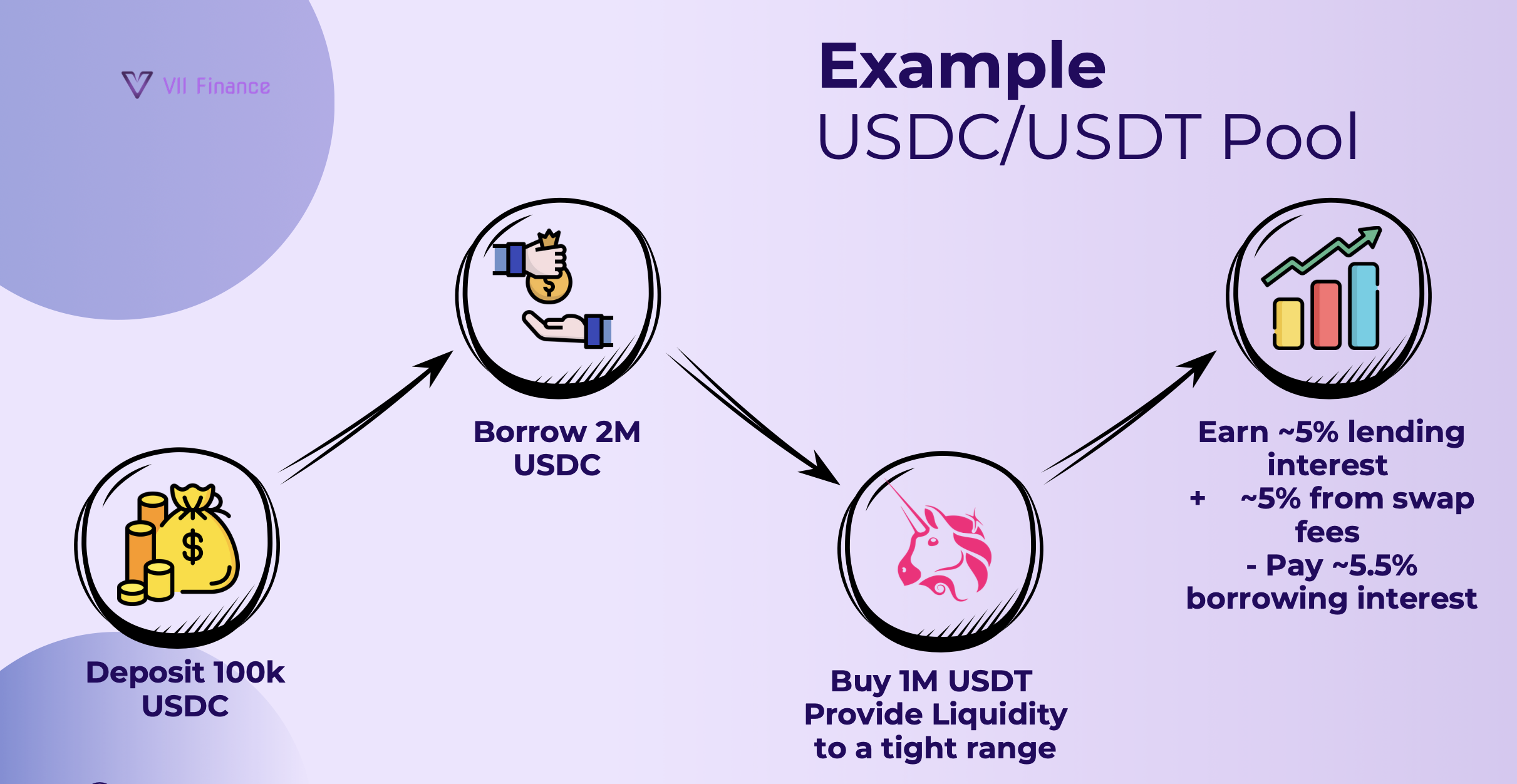Introducing VII Finance
We’re excited to introduce VII Finance, a credit based market making protocol that unlocks a new layer of efficiency and capital productivity in DeFi. At its core, VII Finance allows users to borrow against their Uniswap v4 liquidity positions while continuing to earn lending interest on top of swap fees.
DeFi has always been about composability, and VII Finance is built with that philosophy in mind. Instead of reinventing the wheel, we extend proven primitives, Uniswap v4 and Euler v2, with a novel design that makes liquidity positions more powerful than ever.
Watch the Explainer
How It Works
VII Finance is made up of two major components:
- Uniswap v4 Hook for Earning Lending Interest + Swap Fees
- Credit Layer for Borrowing Against Liquidity Positions
The Uniswap v4 Hook: Earn Lending Interest on Top of Swap Fees
Normally, when you deposit tokens into a lending protocol x, you receive interest bearing tokens (xTokens) whose value increases as interest accrues. A naive attempt to keep earning lending interest while providing liquidity would be to create Uniswap v4 pools using these xTokens, say, xUSDC and xUSDT. The problem is that Uniswap v4 isn’t designed for this. As the value of xUSDC and xUSDT increases, that appreciation is captured by arbitrageurs.
VII Finance solves this with a custom Uniswap v4 hook. Instead of pairing xTokens directly, our hook introduces a vault wrapper (VII-xToken), which separates principal from yield. Pools are created only with the principal tokens, while yield is distributed directly to active LPs in the pool before every action (before adding or removing liquidity and before each swap).
This means LPs can treat the wrapped tokens exactly like the underlying assets, without worrying about interest accrual skewing the price, while still earning lending interest on top of swap fees.
Here’s a simple example of what this enables:
Suppose a vanilla USDC–USDT pool earns 4% from swap fees.
If a user provides liquidity to a pool with same configuration that has our hook enabled, they can earn ~5% from lending interest + 4% from swap fees. Regardless of swap volume, active LPs continue earning the ~5% lending yield.
The Credit Layer: Borrowing Against Liquidity Positions
On the credit side, VII Finance is built as a curator on Euler v2, one of the most battle tested lending protocols in DeFi. Euler v2 provides secure lending markets, robust liquidation mechanisms, and a proven foundation for borrowing and lending.
We extend Euler with a key innovation: Uniswap v4 liquidity positions can now be used as collateral. This unlocks an entirely new design space.
For example, suppose you only have ETH. On VII Finance, you can borrow USDC against it and provide liquidity to the ETH/USDC pair at 2x leverage. There no need to loose ETH exposure by buying USDC with half of your ETH to provide liquidity.
Putting the Two Together

Here’s an example of what a user can do:
Let’s say you have 100,000 USDC. With VII Finance, you can borrow 2M USDC, convert half to USDT, and provide liquidity to the USDC/USDT pool in a tight range using our hook.
Because your LP tokens themselves are accepted as collateral, your effective Loan-to-Value (LTV) ratio is 95%, which is considered safe for stable pairs.
Now, what are your returns on this position?
- Swap Fees: ~5% on the 2M pool
- Lending Yield: ~5%
- Borrowing Cost: ~-5.5% on 2M USDC
On your original 100k USDC, that’s an effective APY of roughly 90%.
This is just one example. Strategies are limited only by the creativity of DeFi users.
Security First
In DeFi, security is everything. Our contracts are immutable, and we delegate the most critical functions to proven protocols rather than reinventing them.
- AMM: Managed fully through Uniswap v4, with our hook ensuring yield distribution before every add/remove liquidity or swap action.
- Lending: Powered by Euler v2, inheriting its superior liquidation and risk management systems.
Still, we know systems are only as strong as their weakest link. That's why we've built an extensive invariant test suite and completed two rigorous external audits. One with Cyfrin covering our core contracts and a second with 33 Audits reviewing the core contracts post mitigation in addition to the Uniswap v4 hook. The most recent audit reported no high or medium severity issues.
For complete details on our security measures and audit reports, visit our Security page.
What’s Next
We’re gearing up to launch on Unichain, and we can’t wait for the community to try VII Finance. This is just the beginning of a new era for credit-based market making, and we’re excited to see the creative strategies that builders, traders, and liquidity providers unlock.
Stay tuned for more updates as we approach our launch!
👉 Explore our Docs
👉 Join the conversation on Discord
👉 Try it out at VII.Finance
